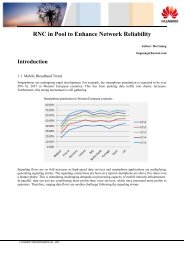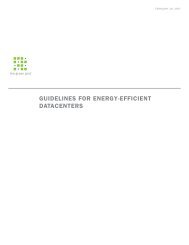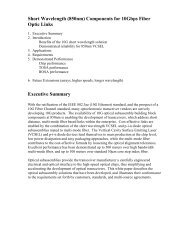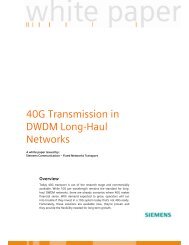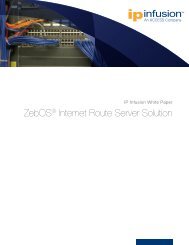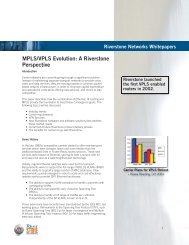GL1800 Refarming, A Cost-effective Way to Win in ... - Light Reading
GL1800 Refarming, A Cost-effective Way to Win in ... - Light Reading
GL1800 Refarming, A Cost-effective Way to Win in ... - Light Reading
Create successful ePaper yourself
Turn your PDF publications into a flip-book with our unique Google optimized e-Paper software.
<strong>GL1800</strong> <strong>Refarm<strong>in</strong>g</strong>, a cost-<strong>effective</strong> way <strong>to</strong> w<strong>in</strong> <strong>in</strong> MBB<br />
<strong>GL1800</strong> <strong>Refarm<strong>in</strong>g</strong>,<br />
A <strong>Cost</strong>-<strong>effective</strong> <strong>Way</strong> <strong>to</strong> <strong>W<strong>in</strong></strong> <strong>in</strong> MBB<br />
Mobile broadband is usher<strong>in</strong>g <strong>in</strong> a brand-new era of communications, <strong>in</strong> which<br />
wireless network traffic will grow explosively by up <strong>to</strong> 500 times <strong>in</strong> ten years.<br />
Traditional GSM voice subscribers are no longer satisfied with low-speed data access.<br />
This has led <strong>to</strong> some <strong>to</strong>ugh questions: What is the right way <strong>to</strong> leverage the spectral<br />
resources of the exist<strong>in</strong>g networks? How should the <strong>in</strong>creas<strong>in</strong>g demand for mobile<br />
data services be addressed? What should be done <strong>to</strong> protect the exist<strong>in</strong>g network<br />
equipment <strong>in</strong>vestment and ensure smooth evolution <strong>to</strong> LTE? Mobile opera<strong>to</strong>rs<br />
worldwide are desperately look<strong>in</strong>g for the answers, and the <strong>GL1800</strong> <strong>Refarm<strong>in</strong>g</strong><br />
solution has been proved <strong>to</strong> be one of the best.<br />
1800MHz: Premier Frequency Band for LTE Deployment<br />
The 1800MHz frequency band is now used ma<strong>in</strong>ly on GSM networks the world over,<br />
accord<strong>in</strong>g <strong>to</strong> 3GPP <strong>in</strong> its def<strong>in</strong>ition of frequency bands for radio communications. It is<br />
also one of the bands def<strong>in</strong>ed for LTE FDD, others <strong>in</strong>clud<strong>in</strong>g DD800MHz and<br />
2600MHz. In addition, Band 3 of 1800MHz has the richest spectral resources, as its<br />
paired FDD spectrum bandwidth reaches 75MHz. More than 50 opera<strong>to</strong>rs <strong>in</strong> over 20<br />
European countries each have more than 10MHz bandwidth <strong>in</strong> this band, accord<strong>in</strong>g <strong>to</strong><br />
statistics from exist<strong>in</strong>g networks. Ma<strong>in</strong>stream Asia-Pacific opera<strong>to</strong>rs <strong>in</strong> countries such<br />
as Ch<strong>in</strong>a, Australia, and S<strong>in</strong>gapore also each have more than 10MHz bandwidth. This<br />
basically guarantees access <strong>to</strong> spectral resources for 1800MHz frequency refarm<strong>in</strong>g.<br />
More importantly, voice traffic carried over GSM900 and GSM1800 is decreas<strong>in</strong>g due<br />
<strong>to</strong> the <strong>in</strong>creas<strong>in</strong>g penetration of UMTS services, subscriber migration, and UMTS<br />
traffic be<strong>in</strong>g mostly carried over the 2,100MHz band. Frequencies <strong>in</strong> the 1800MHz<br />
band can therefore be gradually refarmed <strong>to</strong> be used for more advanced LTE<br />
networks.<br />
The 1800MHz band features lower propagation and penetration losses than the<br />
ma<strong>in</strong>stream 2600MHz band for LTE. It achieves wider coverage as it can multiply the<br />
coverage radius of a s<strong>in</strong>gle LTE station, slash<strong>in</strong>g the number of sites and reduc<strong>in</strong>g<br />
carbon emissions while ensur<strong>in</strong>g high-quality coverage. That will greatly reduce TCO<br />
for opera<strong>to</strong>rs and br<strong>in</strong>g end users better mobile broadband QoE. The <strong>GL1800</strong><br />
<strong>Refarm<strong>in</strong>g</strong> solution results not only <strong>in</strong> significant sav<strong>in</strong>gs on expenditure for new<br />
spectral resources but also faster LTE network deployment. In actual deployment,<br />
opera<strong>to</strong>rs may also opt <strong>to</strong> reuse sites or even equipment based on the status of their<br />
exist<strong>in</strong>g network equipment, realiz<strong>in</strong>g smooth evolution <strong>to</strong> LTE from GSM. When it<br />
comes <strong>to</strong> purchas<strong>in</strong>g new bands and plann<strong>in</strong>g new networks, a refarmed 1800MHz<br />
2012-10-17 Page 1 of 4
<strong>GL1800</strong> <strong>Refarm<strong>in</strong>g</strong>, a cost-<strong>effective</strong> way <strong>to</strong> w<strong>in</strong> <strong>in</strong> MBB<br />
band can play a greater role among the exist<strong>in</strong>g spectral resources. It is a premier<br />
frequency band.<br />
Three Technologies Critical <strong>to</strong> <strong>Refarm<strong>in</strong>g</strong><br />
To come up with an <strong>effective</strong> 1800MHz frequency refarm<strong>in</strong>g solution, three critical<br />
technologies need <strong>to</strong> be taken <strong>in</strong><strong>to</strong> account. The first is about how <strong>to</strong> reallocate<br />
frequencies and control <strong>in</strong>terferences between neighbor<strong>in</strong>g GSM and LTE<br />
frequencies. The second is about the method of migrat<strong>in</strong>g GSM voice service<br />
subscribers <strong>to</strong> release part of the 1800MHz spectrum. And the third is how different<br />
networks should be coord<strong>in</strong>ated.<br />
For frequency reallocation, there are two ma<strong>in</strong>stream methods commonly used <strong>in</strong> the<br />
<strong>in</strong>dustry, namely full refarm<strong>in</strong>g and partial refarm<strong>in</strong>g. Full refarm<strong>in</strong>g is suitable for<br />
mobile opera<strong>to</strong>rs with well developed GSM and UMTS networks and rich spectral<br />
resources. The number of GSM/GPRS subscribers is decreas<strong>in</strong>g as UMTS services<br />
are grow<strong>in</strong>g and these subscribers are be<strong>in</strong>g migrated <strong>to</strong> UMTS networks, lead<strong>in</strong>g <strong>to</strong><br />
fewer loads on the GSM network at 1800MHz. Therefore, the 1800MHz spectrum can<br />
be fully refarmed <strong>to</strong> be used for LTE networks, while all the voice services are borne<br />
by GSM900.<br />
Partial refarm<strong>in</strong>g is suitable for the opera<strong>to</strong>rs with limited spectral resources who have<br />
no UMTS networks and have difficulty <strong>in</strong> subscriber migration or who have a large<br />
number of GSM subscribers that will rema<strong>in</strong> stable <strong>in</strong> the short term. These opera<strong>to</strong>rs<br />
need <strong>to</strong> consider how <strong>to</strong> reta<strong>in</strong> the exist<strong>in</strong>g subscribers and provide competitive<br />
high-speed mobile data access. They may therefore phase <strong>in</strong> the band refarm<strong>in</strong>g <strong>to</strong><br />
LTE by 5MHz or 10MHz spectrum bandwidth. Partial refarm<strong>in</strong>g is done by two<br />
methods – the sandwich method and the edge allocation method. The sandwich<br />
method releases the middle portion of the 1800MHz band of an opera<strong>to</strong>r <strong>to</strong> LTE by<br />
5MHz or 10MHz spectrum bandwidth. Portions on both ends are still used by GSM.<br />
As for the edge allocation method, it allocates either end of the band possessed by<br />
the opera<strong>to</strong>r <strong>to</strong> LTE and keeps the other end for GSM. The sandwich method is<br />
recommended, given the GSM frequency reuse plan, <strong>in</strong>terferences between<br />
frequencies and, <strong>in</strong> particular, <strong>in</strong>terferences with other opera<strong>to</strong>rs. Control over<br />
<strong>in</strong>terferences between GSM and LTE can be done with<strong>in</strong> the frequency band owned<br />
by an opera<strong>to</strong>r without need<strong>in</strong>g <strong>to</strong> coord<strong>in</strong>ate neighbor<strong>in</strong>g bands of other opera<strong>to</strong>rs.<br />
Also based on the preced<strong>in</strong>g two frequency refarm<strong>in</strong>g methods, space division may<br />
be used <strong>to</strong> <strong>effective</strong>ly reduce mutual frequency <strong>in</strong>terferences between GSM and LTE.<br />
Opera<strong>to</strong>rs may push refarm<strong>in</strong>g from cities <strong>to</strong> suburbs, or vice versa, from the<br />
perspectives of network loads and subscriber needs. They may first refarm some<br />
frequencies for LTE <strong>to</strong> satisfy the demand for mobile data <strong>in</strong> urban areas, for example.<br />
As for non-urban areas, they do not need <strong>to</strong> refarm frequencies and may <strong>in</strong>stead keep<br />
us<strong>in</strong>g their own full-bandwidth GSM bands s<strong>in</strong>ce there is no strong demand for<br />
2012-10-17 Page 2 of 4
<strong>GL1800</strong> <strong>Refarm<strong>in</strong>g</strong>, a cost-<strong>effective</strong> way <strong>to</strong> w<strong>in</strong> <strong>in</strong> MBB<br />
high-speed mobile data services <strong>in</strong> these areas.<br />
Mutual <strong>in</strong>terferences of the same band between LTE and GSM should be avoided, as<br />
they often take place when this same band is used for LTE <strong>in</strong> urban areas and still for<br />
GSM <strong>in</strong> non-unban areas. Geographically, a transitional zone may be set between a<br />
city and its suburbs, where this band is left unused, <strong>to</strong> spatially prevent <strong>in</strong>terferences<br />
caused by the use of the same band for both technologies.<br />
Migrat<strong>in</strong>g their GSM voice service subscribers is a <strong>to</strong>ugh choice for opera<strong>to</strong>rs, who<br />
have <strong>to</strong> <strong>in</strong>crease the data access capacity of the exist<strong>in</strong>g networks – they have <strong>to</strong><br />
reduce the bandwidth of GSM and accommodate exist<strong>in</strong>g subscribers at the same<br />
time. There are now two critical technologies <strong>to</strong> deal with this issue: half-rate voice<br />
(HRV) and aggressive frequency reuse (AFR). HRV bears the same number of voice<br />
service subscribers with a half bandwidth. AFR saves on bandwidth by 25 <strong>to</strong> 50%<br />
depend<strong>in</strong>g on configurations rang<strong>in</strong>g from S2/2/2 <strong>to</strong> S7/7/7. Opera<strong>to</strong>rs may employ<br />
those technologies flexibly.<br />
Coord<strong>in</strong>ation between GSM/UMTS and LTE networks is another critical issue <strong>in</strong><br />
frequency refarm<strong>in</strong>g. It guarantees load balance between different types of networks<br />
and the <strong>in</strong>heritance of voice services, while provid<strong>in</strong>g network selection priorities<br />
based on services, loads, and subscriber characteristics. Meanwhile, mobility should<br />
be guaranteed between the two networks, <strong>in</strong>clud<strong>in</strong>g handover and <strong>in</strong>teroperability<br />
between the CS and PS doma<strong>in</strong>s. 3GPP has already def<strong>in</strong>ed the coord<strong>in</strong>ation<br />
between heterogeneous networks and set down specifications, lay<strong>in</strong>g a foundation for<br />
coord<strong>in</strong>ation between networks us<strong>in</strong>g different technologies.<br />
Three Schemes for <strong>Refarm<strong>in</strong>g</strong> Solution Deployment<br />
If the preced<strong>in</strong>g technologies are preconditions for deploy<strong>in</strong>g the <strong>GL1800</strong> <strong>Refarm<strong>in</strong>g</strong><br />
solution, then equipment performance and evolution capabilities are tied <strong>to</strong> the TCO,<br />
and the progress and feasibility of network deployment.<br />
As the first of its k<strong>in</strong>d, Huawei’s S<strong>in</strong>gleRAN solution supports GSM, UMTS, and LTE<br />
as well as the five bands of DD800MHz, 900MHz, 1800MHz, 2100MHz, and<br />
2600MHz, <strong>in</strong> the same cab<strong>in</strong>et. Its advantages become more outstand<strong>in</strong>g <strong>in</strong> <strong>GL1800</strong><br />
deployment. This solution supports shar<strong>in</strong>g of stations, transmission, ma<strong>in</strong>tenance,<br />
and RF. It helps opera<strong>to</strong>rs evolve smoothly <strong>to</strong> LTE1800 from GSM1800, or realize<br />
coexistence of GSM and LTE <strong>in</strong> the 1800MHz band.<br />
As can be seen from RF modules <strong>to</strong> antenna feeder deployment schemes, the core<br />
issue with deploy<strong>in</strong>g a new LTE1800 network on <strong>to</strong>p of the exist<strong>in</strong>g GSM1800 network<br />
is the RF module based antenna feeder solution. There are three deployment<br />
schemes by scenarios:<br />
The first scheme is completely separat<strong>in</strong>g RF modules and antenna feeders. As<br />
2012-10-17 Page 3 of 4
<strong>GL1800</strong> <strong>Refarm<strong>in</strong>g</strong>, a cost-<strong>effective</strong> way <strong>to</strong> w<strong>in</strong> <strong>in</strong> MBB<br />
GSM1800 RF modules do not support multi-mode capabilities and have limited<br />
transmission power, RF modules and antenna feeders are separated <strong>to</strong> ensure the<br />
quality of coverage. This scheme is characterized by high <strong>in</strong>vestment, the<br />
requirement for a site, and difficulties <strong>in</strong> deployment.<br />
The second is separat<strong>in</strong>g RF modules but shar<strong>in</strong>g antenna feeders. This scheme is<br />
suitable for scenarios where RF module’s multi-mode support capabilities or operat<strong>in</strong>g<br />
bandwidths are limited. Though requir<strong>in</strong>g new RF modules, the scheme allows for the<br />
shar<strong>in</strong>g of the antenna feeder system through comb<strong>in</strong>ers <strong>to</strong> save on the space where<br />
antenna feeders are mounted. The negative side of this scheme <strong>in</strong>cludes the addition<br />
of comb<strong>in</strong>ers and, typically, additional 3dB <strong>in</strong>sertion loss, which affects the<br />
transmission power <strong>to</strong> some extent.<br />
The third is shar<strong>in</strong>g both RF modules and antenna feeders. This scheme fully reuses<br />
the exist<strong>in</strong>g antenna feeder system and RF modules with no need <strong>to</strong> add any<br />
hardware after they come out of the base band’s CRPI. Nonetheless, this scheme<br />
requires RF modules <strong>to</strong> have multi-mode capabilities and higher operat<strong>in</strong>g<br />
bandwidths, guarantee use <strong>in</strong> discrete frequencies at 1800MHz, and support future<br />
bandwidth <strong>in</strong>creases. Meanwhile, they should accord<strong>in</strong>gly have higher transmission<br />
power. In Huawei’s S<strong>in</strong>gleRAN solution, the RF modules feature multi-mode<br />
capabilities, dual channels, full bandwidth, and high power, help<strong>in</strong>g opera<strong>to</strong>rs save on<br />
CAPEX and facilitat<strong>in</strong>g network deployment. The solution is the best choice for<br />
<strong>GL1800</strong> refarm<strong>in</strong>g.<br />
The 1800MHz band is one of the ma<strong>in</strong> frequency bands commonly used by mobile<br />
opera<strong>to</strong>rs, and also an <strong>effective</strong> supplement <strong>to</strong> the GSM900 network. In the<br />
foreseeable future, with mobile data services leapfrogg<strong>in</strong>g, traditional GSM voice<br />
service subscribers will be gradually migrated <strong>to</strong> UMTS or LTE networks. Given<br />
current spectral resources, the <strong>GL1800</strong> <strong>Refarm<strong>in</strong>g</strong> is one of the best solutions for<br />
keep<strong>in</strong>g network competitiveness, reduc<strong>in</strong>g <strong>in</strong>vestment and rapidly deploy<strong>in</strong>g LTE<br />
networks.<br />
2012-10-17 Page 4 of 4







